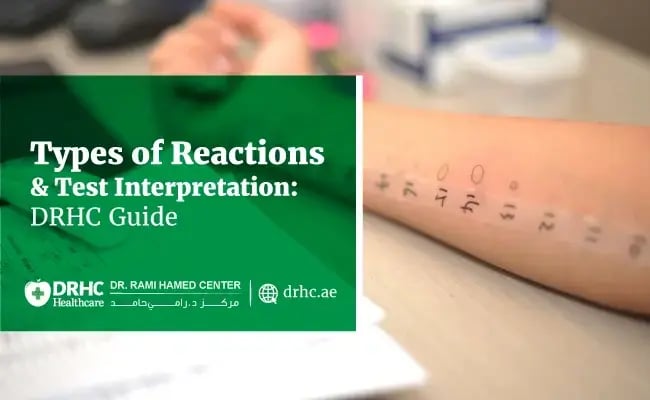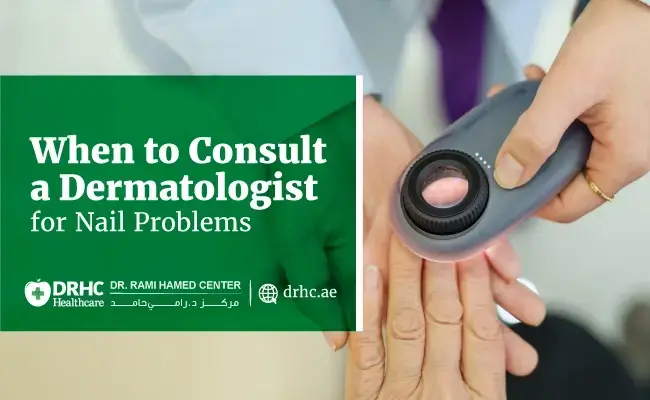
When it comes to skin allergies, one of the biggest challenges patients face is identifying the exact trigger. Whether it’s a cosmetic ingredient, a cleaning product, or even pollen in the air, these allergens can cause frustrating symptoms that interfere with daily life.
At Dr. Rami Hamed Center (DRHC) in Dubai, we use safe and precise skin allergy tests—such as patch tests and prick tests—to help patients discover what’s behind their allergic reactions. Understanding how these tests work and how their results are interpreted can help you feel more confident about your diagnosis and next steps.
What Happens During a Skin Allergy Test?
A skin allergy test exposes your skin to small amounts of potential allergens under controlled conditions. Your skin’s reaction—if any—helps identify what substances are causing irritation or immune responses.
There are two common types of tests performed at DRHC Dubai:
- Prick Test (Skin Prick or Scratch Test) – used to detect immediate allergies such as reactions to dust, pollen, or certain foods.
- Patch Test – used to diagnose delayed reactions, often caused by contact allergens like fragrances, metals, or preservatives.
Once the test is performed, the dermatologist observes your skin’s response and records any visible changes, such as redness, swelling, or bumps.
Types of Reactions Seen After Allergy Testing
1. Negative Reaction – No Sensitivity Detected
If your skin remains normal without any redness, swelling, or itching, it means no sensitivity was detected to that specific allergen. A negative reaction helps rule out certain causes and allows your dermatologist to focus on other potential triggers.
2. Mild Positive Reaction – Slight Redness or Itching
A small red bump or mild itching at the test site suggests a low-level sensitivity. This type of reaction may not always cause visible symptoms in daily life, but indicates that your skin is somewhat reactive to the substance.
3. Moderate Positive Reaction – Noticeable Redness or Swelling
When redness, swelling, or a raised bump appears, it usually means your immune system is reacting to that allergen more strongly. The dermatologist may advise you to limit exposure or avoid the substance altogether, depending on how frequently you encounter it.
4. Strong Positive Reaction – Blistering or Severe Redness
A strong reaction with blisters or intense redness shows a clear allergy to that specific allergen. The dermatologist will explain how to manage and prevent future exposure to avoid severe flare-ups.
It’s important to remember that these reactions are localized and temporary—they typically fade within a few hours to a few days.
How Dermatologists Interpret Allergy Test Results at DRHC Dubai
After your test, your dermatologist will carefully examine and document the reactions. The interpretation is not just about what is positive or negative—it’s about understanding the clinical relevance of each reaction.
Here’s how results are evaluated at DRHC Dubai:
- Timing: Immediate reactions are usually linked to inhaled or food allergens, while delayed ones are associated with contact substances.
- Severity: The intensity of the redness or swelling helps determine how reactive your skin is to that allergen.
- Symptoms: The dermatologist compares test reactions with your real-life symptoms to ensure an accurate diagnosis.
- Exposure History: Your daily habits, skincare products, and environment are considered before final recommendations are made.
This detailed evaluation ensures that the results are meaningful—not just on paper, but in guiding your real-world care.
Common Concerns About Allergy Test Reactions
Is it normal to have redness or itching after the test?
Yes. Mild redness or itching at the test site is expected and usually fades on its own. If you experience discomfort, your dermatologist may recommend a soothing cream.
Can a test cause an allergic flare-up?
The amount of allergen used is very small, so it’s unlikely to cause a major reaction. Testing is performed in a controlled environment, ensuring your safety.
When will I get my results?
For prick tests, results are typically available within 20–30 minutes. For patch tests, results are read over two to three days to allow delayed reactions to develop.
What should I do after the test?
Avoid scratching the test area and follow any care instructions provided by your dermatologist. If you have a patch test, try to keep the area dry until the final reading.
What Happens After the Results?
Once your test is interpreted, your dermatologist at DRHC Dubai will explain the findings in clear, simple terms. You’ll receive personalized advice that may include:
- Avoidance strategies for confirmed allergens
- Medication or topical treatments to relieve symptoms
- Lifestyle and skincare guidance to prevent future reactions
- Follow-up testing if multiple allergens or complex conditions are involved
At DRHC, our goal is to not only diagnose the problem but to help you regain confidence and comfort in your skin.
When to Seek Medical Attention After Testing
If you notice excessive redness, swelling, or discomfort after testing, it’s best to contact your dermatologist. These reactions are rare but can be easily managed with medical care.
Conclusion
Allergy tests can provide valuable answers to ongoing skin concerns, helping you understand what your body reacts to and how to manage it effectively. At Dr. Rami Hamed Center (DRHC) Dubai, we take a personalized and science-based approach to interpreting your allergy test results—ensuring clarity, comfort, and lasting relief.
If you’re experiencing frequent or unexplained skin reactions, booking a consultation at DRHC Dubai can be your first step toward healthier, more comfortable skin.
📞 Call / WhatsApp: +97142798200
📍 Visit Us: Dr Rami Hamed Center, Dubai Healthcare City
🌐 Website: www.drhc.ae
Topic: Dermatology








Leave a comment